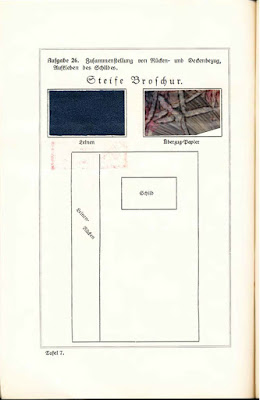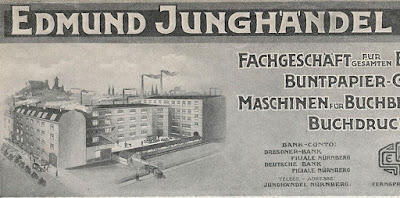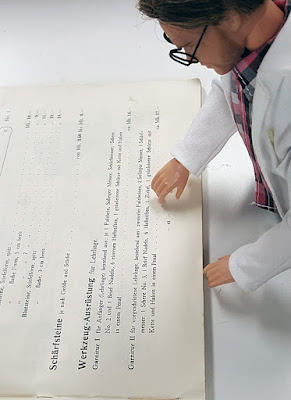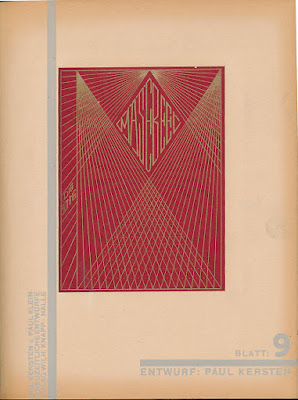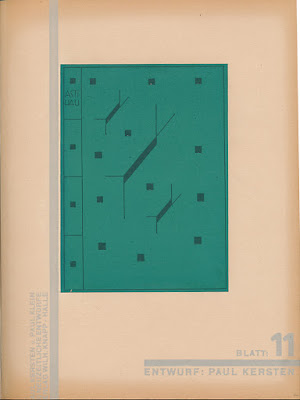Another recent acquisition, Die Buchbinderin, #5 in the series Die Frau im Handwerk (Women in the Trades). The pamphlet was written by Agnes Richter, herself a Buchbindermeisterin, and published with permission of the Soviet military administration in 1949.
In short it outlines the trade and apprenticeship in the way it would have been introduced and experienced by Babette/Bärbel.
 |
Cover showing the seals of the trades in the series.
See the last image for the other publications in the series. |
 |
The series was written for all women thinking about starting a
career in the trades, other trade Meister, the Guilds, etc. |
 |
| The authors' forward |
Forward: This small pamphlet is particularly written for those women and girls deciding what trade and career to choose. I want to introduce a trade to them, one that has always employed women, but is particularly encouraging them formally learn the trade.
I want to describe the bookbinding trade and all of its varied facets so that girls leaving school and women contemplating a new career are filly informed about the work, apprenticeship, the exams, and opportunities for advancement.
I would be delighted if this publication helped career guidance counselors and supports the trade unins in their work. They could bring eager and interested future binders to the trade.
To those in the trade, I ask you to share your critiques so that I can update and improve this publication.
To those that helped finding illustrations and other documentation, my heartfelt thanks.
The author
 |
Some statistics from Die Buchbinderin.
The years 1939 and 1942 are being compared. |
In 1939 there were 7697 binderies in the trade, in 1942, 5498.
The table above shows how those working in these binderies were represented by type. Left column: Bindery owners, family members as "helpers", salaried staff, journeymen, apprentices, workers, totals. Top row: ["type"], [year], male total, male %, female total, female %, trade average %.
1939 and 1942 are interesting years to compare. In 1939 the war in Europe had really started, and by the end of 1942 the outcome would become much clearer. How much of the decline in binderies and males can be attributed to being closed, bombed out, drafted for the front, ...? The increase in females partially also to replace males lost, like Rosie the Riveter. Based on the print run figures in some of my earlier copies of
Der Buchbinderlehrling, a comparison between pre-1929 (let's say 1927) and some time in the early 50s would have given a better sense, but that would be after this pamphlet came out. The
Buchbinderlehrling would definitely have been required reading for apprentices represented in the date range of the table.
 |
Binding by Maria Lühr (in German with pictures), first
Buchbindermeisterin in Germany. Lühr got her start with
W. Collin in Berlin and studied with Cobden-Sanderson, among others.
She also wrote the introduction to the 2nd German edition of Cockerell's
Bookbinding and the Care of Books (1925). |
 |
| Bookbinder working on a folding machine. |
 |
| Apprentices making cases for books. |
 |
| The Meisterin checking the work of the apprentices. |
 |
From the author's conclusion
|
In her conclusion, the author offers practical suggestions about the career prospects and options for a master bookbinder. Among these other paper-based trades, work in libraries and archives, in conjunction with a small paper goods store. In the case of the latter, this would ideally be with the binder's husband or someone else who could run the store so that the binder could focus on the actual binding work.
She also responds to the often asked question of why invest in the training of women through to their master's certificate if they are likely to leave the trade to get married to focus on raising a family and managing a household. In her answer she points out that the number of women who will find husbands after the lost war (remember this was written in 1949) is substantially lower, and that as a result of labor shortages women will still be needed to contribute to a family's income, even in the best of circumstances. These women will be glad that they will be able to continue in their chosen careers and not have to take in odd work-from-home piecework. Yes, a portion of these women will leave the trade, but there are also plenty of men who do the same and were thus lost to the trade.
So, for those that stick with it and practice their trade and craft to the highest standards, there will always be opportunities.
 |
The list of other publications in the Series.
#1 a general introduction; #2, the potter; #3, the glassblower;
#4 the spinner and weaver; # 5 the bookbinder. The list of those in preparation
is quite representative of the trades learned by men and women. |
Now, in the 21st century the tables have flipped and women represent the majority of those learning and working as bookbinders (and conservators). At the same time, the numbers of binderies and available positions have contracted greatly due to any number of changes. On the positive side, the number of people practicing the books arts and number of learning opportunities has been increasing for decades. Those experiences cannot be compared to the traditional trade apprenticeships, schools, and overall situation described in Die Buchbinderin and publications like the Buchbinderlehrling and its successor Das Falzbein that ceased publication in 1960... I still need to write up a summary like I did for the Buchbinderlehrling.
%20sm%20b.jpg)
%20sm.jpg)
%20sm.jpg)















